In this age of titanium folding knives, state-of-the-art bushcraft blades, and $500 tactical tomahawks, it's easy to overlook one of the best survival tools that most us already own: the little red knife with the corkscrew.
A Victorinox Swiss Army knife is a small toolbox in your pocket. Have you ever cringed watching someone break the tip off his tactical knife while trying to turn a screw or pry a lid? Perhaps you've seen someone work up a sweat damaging or dulling his big blade while chopping or batoning a sapling, when a small saw blade would have sufficed? Tasks are often easier when you use the right tool. Swiss Army knives are available in many models, giving you lots of tool combinations to choose from without having to carry an entire toolbox. And no, not all of them feature corkscrews, and not all of them are red.
We've used this multitool in the woods and around the house, to prepare tinder, fashion snare triggers, tighten screws, strip wires, file corroded wires, open cans, repair toys, make an alcohol stove from a tuna can, and clear shooting lanes while. Once, on a high-profile detail as a police officer, this author even used the scissors on a Swiss Army knife to self-administer an emergency haircut when a grouchy superior officer went on a rant about “non-regulation” hair.
When it comes to matters of survival, a Swiss Army knife can be a lifesaver, too. Here we highlight five of the most unexpected uses for everyone's favorite little red multitool. For more useful survival hacks and tips, check out our book OFFGRID Presents: DIY Survival, on sale now.
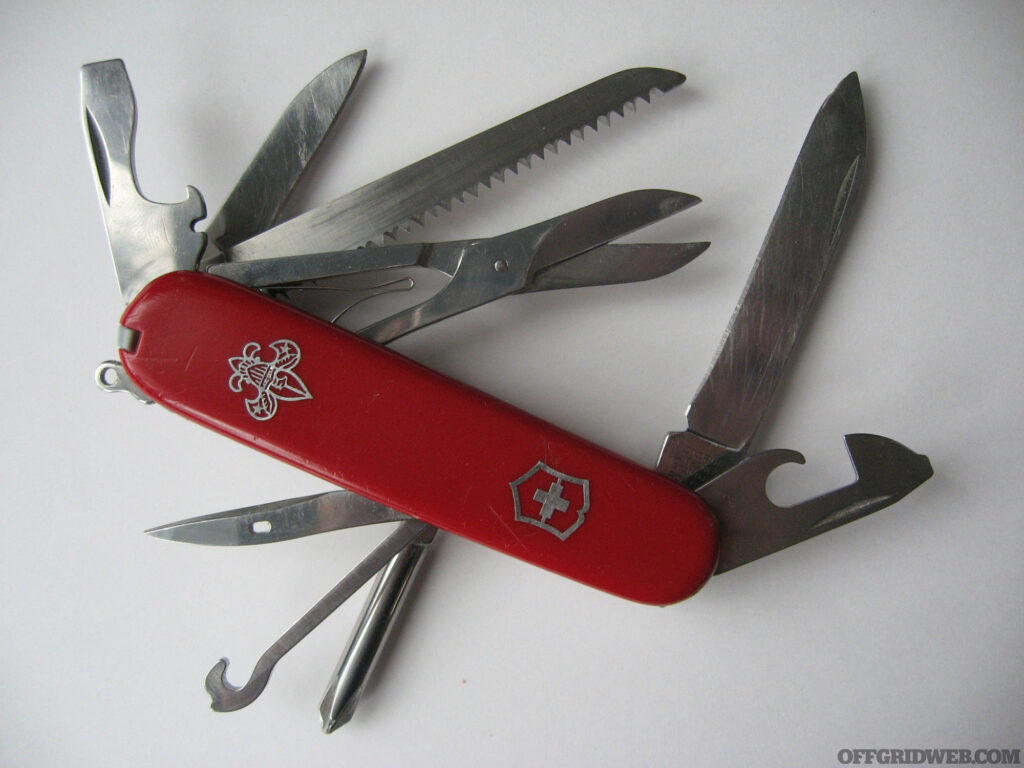
Swiss Army Knife Basic Features
- Main Blade: A sharp, stainless steel blade that folds into the handle.
- Smaller Secondary Blade: Often included for more delicate cutting tasks.
- Can Opener: Paired with a small screwdriver tip that works on flat-head screws.
- Bottle Opener: This is usually combined with a larger screwdriver tip and also sometimes includes a wire stripper notch.
- Scissors: Useful for cutting paper, trimming cloth, or other fine work.
- Saw: A serrated blade that can saw through wood and other materials.
- Awl or Reamer: A pointed tool for punching holes in leather or wood.
- Corkscrew: For opening wine bottles.
- Tweezers: Slotted into the casing, handy for picking up small objects or removing splinters.
- Toothpick: A small plastic pick that can be used for cleaning.
- Key Ring: Allows the knife to be attached to keys or gear.
- Phillips Screwdriver: Some models include a Phillips head screwdriver.
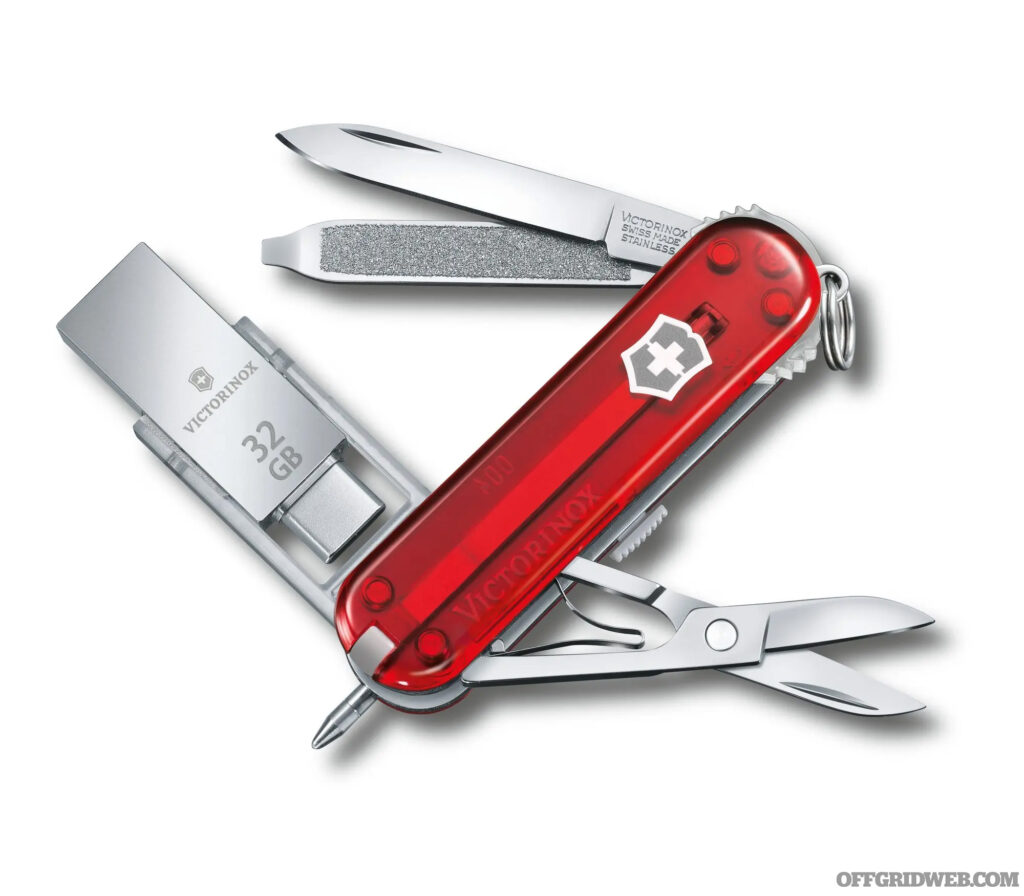
Additional features can include various other tools like a nail file, magnifying glass, pliers, fish scaler, hook disgorger, pen, digital clock, altimeter, USB stick, and even an LED light in some of the more modern or specialized versions. The specific tools included can vary widely from one Swiss Army knife to another, depending on the model and intended use.
Caring for a Swiss Army Knife
Taking care of a Swiss Army knife ensures it remains functional and lasts for many years. Here are some of the best care and maintenance tips:
- Cleaning: After use, especially if it has come into contact with acidic substances or dirt, clean the blades and tools with warm water and a mild detergent. Make sure to open and clean each tool individually.
- Drying: Thoroughly dry the knife after washing. Moisture can lead to rust and degradation of the metal components. Leave the tools out in a dry area or use a dry cloth to remove any moisture.
- Oiling: Apply a drop of oil to the pivot points of the blades and tools to keep the action smooth. Use a lubricant that's safe for multi-tools and pocketknives.
- Sharpening: Keep the blades sharp with a sharpening stone, honing rod, or a knife sharpener suitable for small blades. A sharp knife is safer and more efficient.
- Tightening: The screws on the knife can become loose over time. Tighten them gently with a suitable screwdriver to ensure that the tools do not wobble.
- Avoid Rust: Prevent rust by storing the knife in a dry place and avoiding prolonged exposure to wet environments. If rust does form, remove it with a rust remover appropriate for cutlery.
- Regular Inspection: Periodically check the knife for any signs of wear or damage. Inspect the tools for sharpness, the handle for stability, and the overall function of the knife.
- Proper Usage: Use the knife for its intended purposes only. Avoid using the knife as a pry bar, screwdriver as a chisel, or the blade as a hammer, as misuse can lead to damage.
- Carrying Case: If you carry the knife daily, consider using a protective pouch or case to prevent dirt build-up and to protect it from the elements.
- Avoiding Improper Storage: Do not store the knife in its sheath for long periods, especially if the sheath is leather, as leather can attract moisture and cause rust.
- Avoid Dishwashers: The high heat and harsh detergents can damage the knife. Always opt for hand washing.
- Polishing: For aesthetic maintenance, polish the knife with a metal polish appropriate for stainless steel, but ensure it's suitable for cutlery to avoid contamination of food.
5 Surprising Uses For a Swiss Army Knife
Survival Use #1: Start a Fire
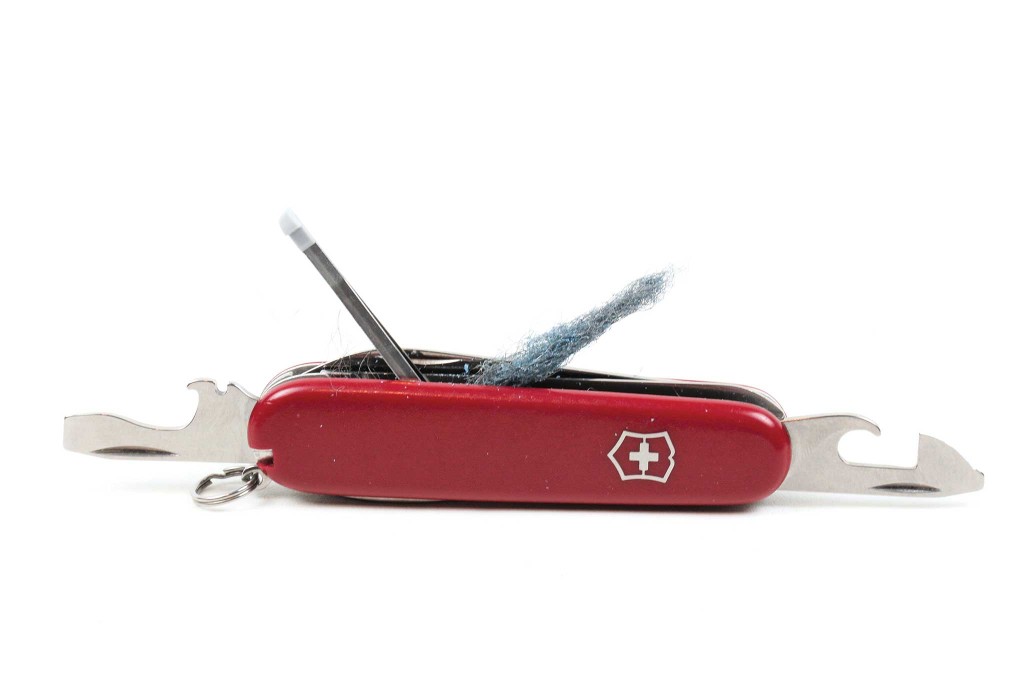
In a survival situation, you need to be able to make fire. You might carry a lighter and a ferrocerium rod with you, but those aren't the only sources of ignition. Our backup fire-starting kit uses a small piece of steel wool, the battery from a tactical flashlight, and, yes, our Swiss Army knife. The knife holds the battery in place and also forms most of the electrical circuit.
Step 1: Store a piece of steel wool inside your Swiss Army knife. Here's an easy way to do this. First, open the bottle opener and can opener on each end of your knife. Take a piece of steel wool and twist it in your fingers until you have a strong, twine-like piece just shorter than your knife is long. Push this inside the knife using the tweezers or toothpick, then close the can and bottle openers on top of it.
Step 2: When you're ready to start a fire, open the can opener all the way, but open the bottle opener just halfway, so that it's perpendicular to the rest of the knife. Remove your steel wool from inside and untwist some of it. You won't need much.
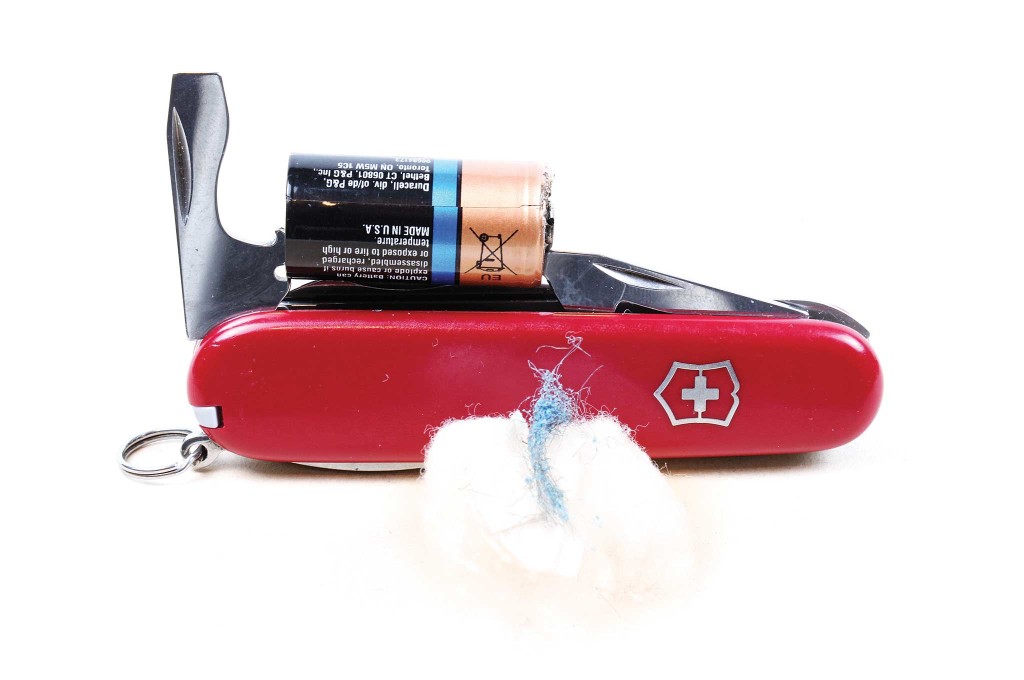
Step 3: Place several strands of steel wool into a tinder bundle about the size of your thumbnail. A cotton ball with some shredded paper mixed in works well.
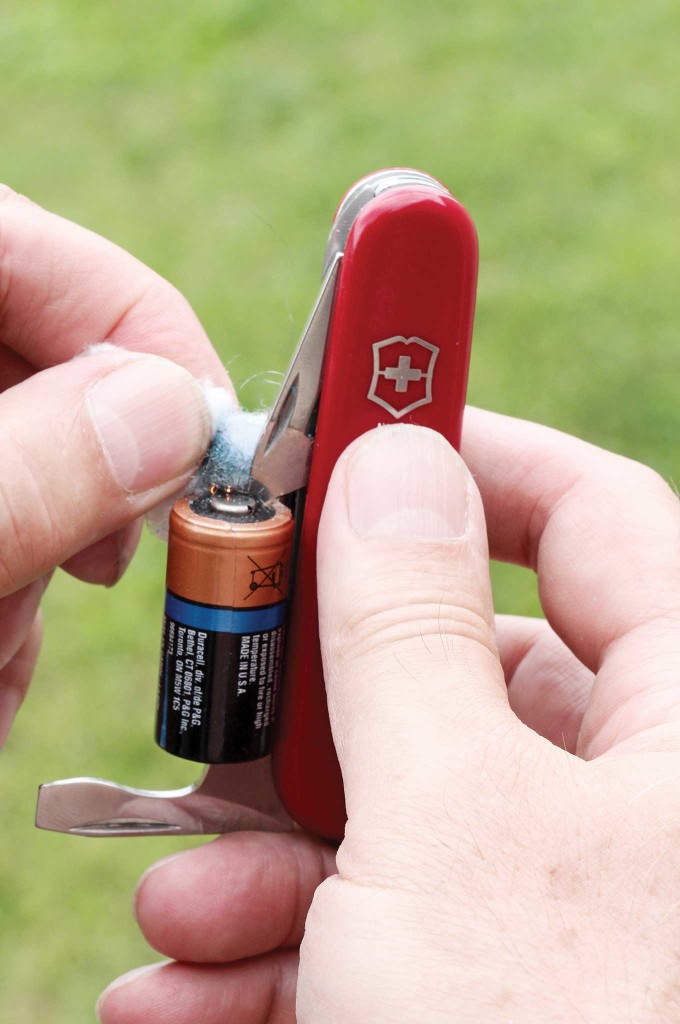
Step 4: Remove a CR123A or similar battery from your tactical flashlight. Place the flat, negative end of the battery against the upright bottle opener. Lift the front of the battery slightly, and slowly close the can opener until it rests against the top of the battery, leaving a slight gap between the can opener and the positive nub of the battery. The battery should now be held in place by those two Swiss Army tools.
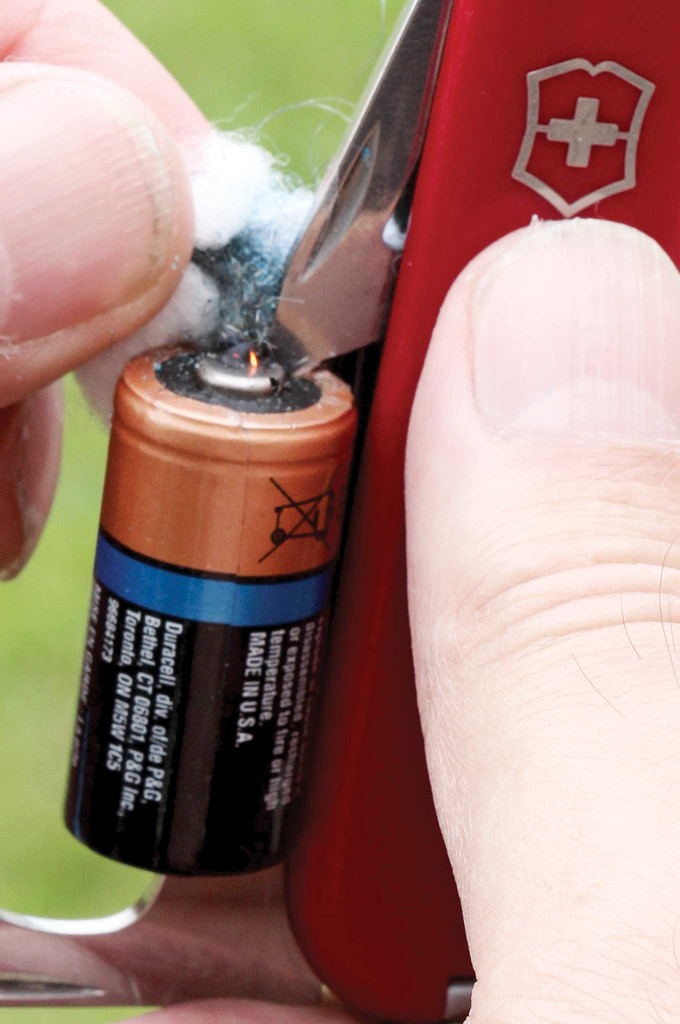
Step 5: Holding the knife upright in one hand and the tinder/steel wool in the other, position the strands of steel wool so that it touches the positive terminal of the battery and the can opener. This completes the electrical circuit. The current will run from the battery through the knife to the steel wool and back to the battery. The steel wool is so fine that it'll heat up rapidly and begin to glow, until it catches the tinder on fire.
Note: Like many survival techniques, this requires practice, both to get the steel wool glowing hot and then to fan or blow the right amount of air onto a resulting ember in the tinder until it bursts into flame. This caught the author by surprise the first time he tried it, burning a thumb. Make sure you have other tinder and kindling ready nearby to keep your fire going.
Survival Use #2: Build a Stove
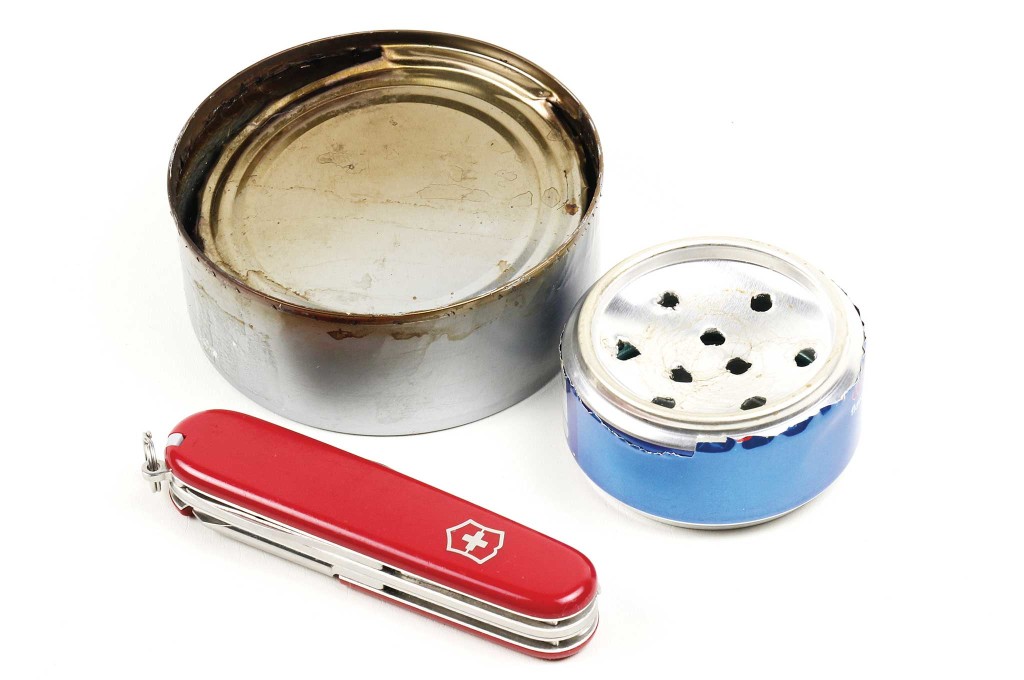
There are many ways to make various types of alcohol stoves. Our favorite — and one of the easiest — uses a small potted meat can with two rows of holes punched around the top rim. The cook pot sits right on top, and the flames jet out of the holes. But what if your Swiss Army knife is your only tool? No problem. Here are two simple stoves you can make, one with a tuna can and the other with the bottoms of two soda cans.
Tuna Can Stove:
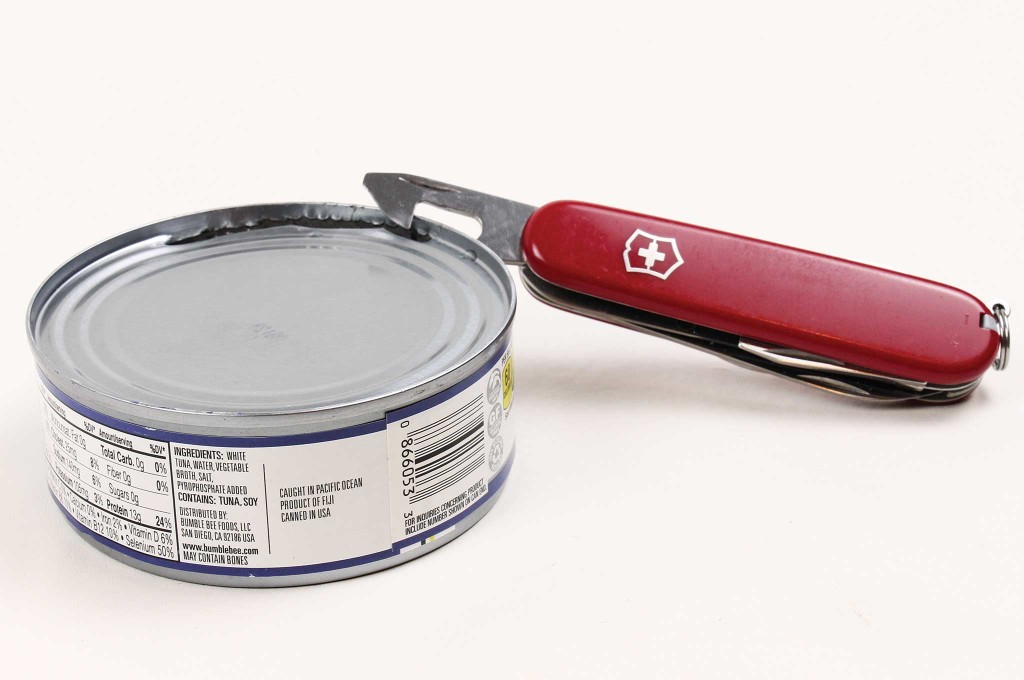
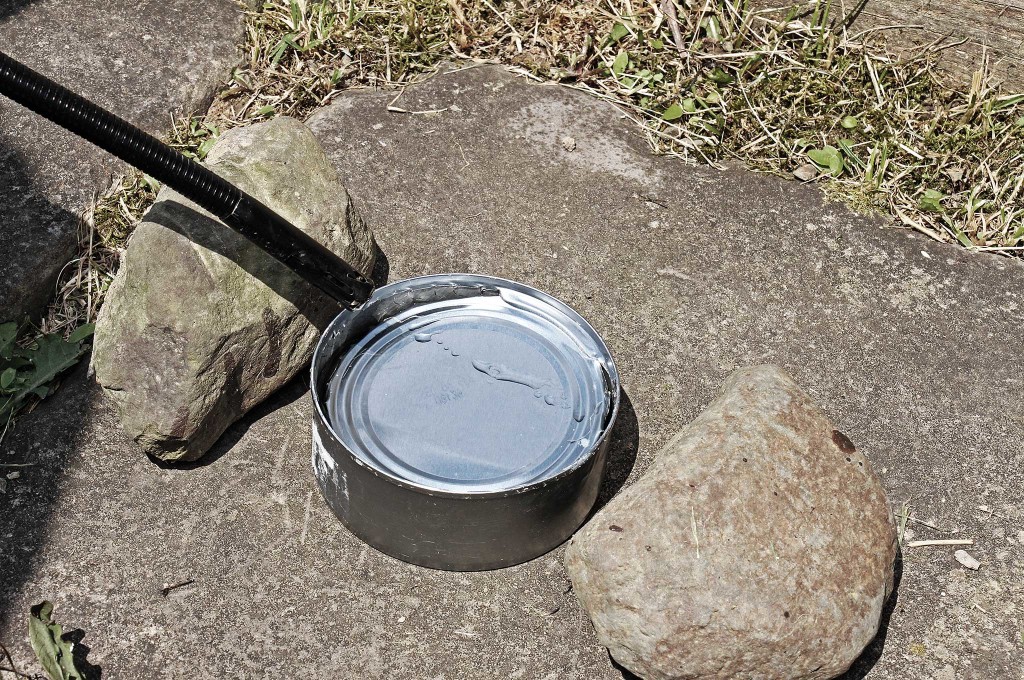
Step 1: Using the can opener on your Swiss Army knife, open the can of tuna, but don't completely remove the lid.
Step 2: Eat the tuna. It's good for you.
Step 3: Fold the lid back into the can.
Step 4: Fill the can with methyl alcohol — either denatured alcohol from a hardware store (used as paint thinner) or Heet brand gas-line antifreeze (the one in the yellow bottle). You can find Heet in most convenience stores.
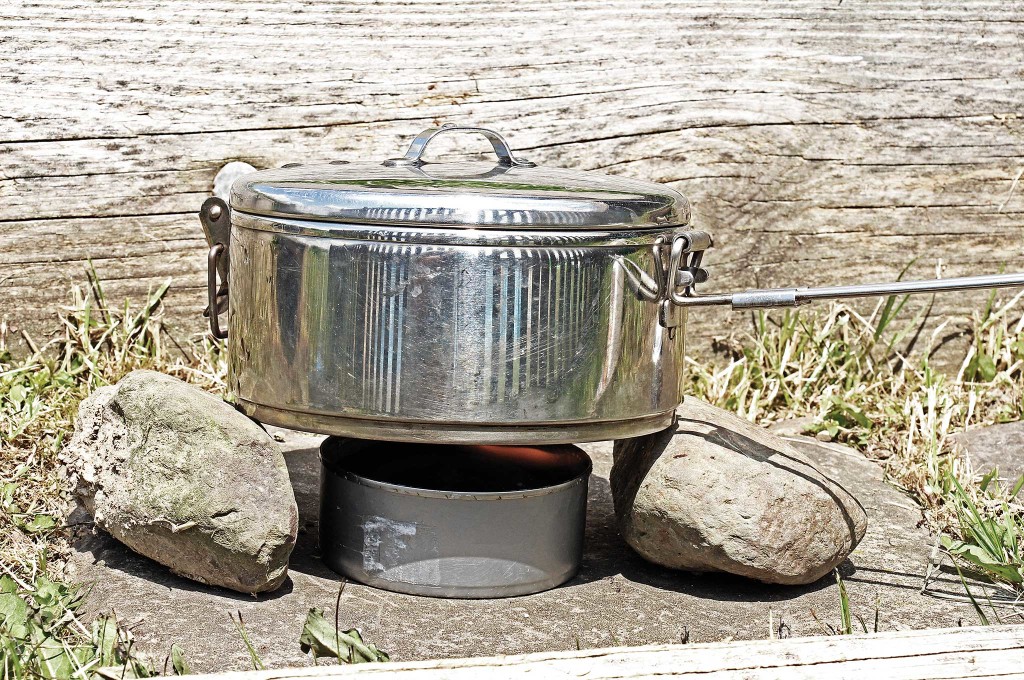
The A-frame of the travois laid out and ready to be lashed together.
Step 5: Place a couple of small stones (flat tops preferred) on either side of your stove to serve as your pot support.
Step 6: Light the stove. The flames will shoot through the gaps you cut between the can rim and the lid.
Step 7: Place your cook pot across the stones. Ideally, there should be an inch or less of space between the stove and your pot.
Soda Can Stove:
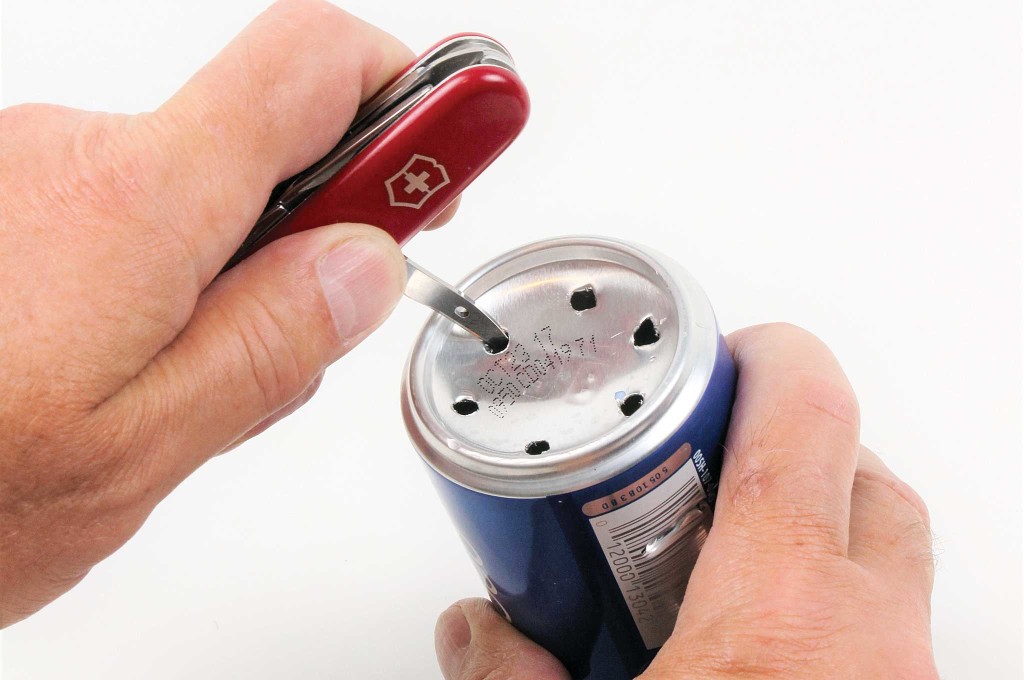
Step 1: Begin with two empty soda cans with concave bottoms. Using the reamer tool of your Swiss Army knife, bore 6 to 10 holes in the bottom of one can, being careful not to let the reamer blade close on your fingers. The metal on soda cans is thin, so boring holes isn't difficult.
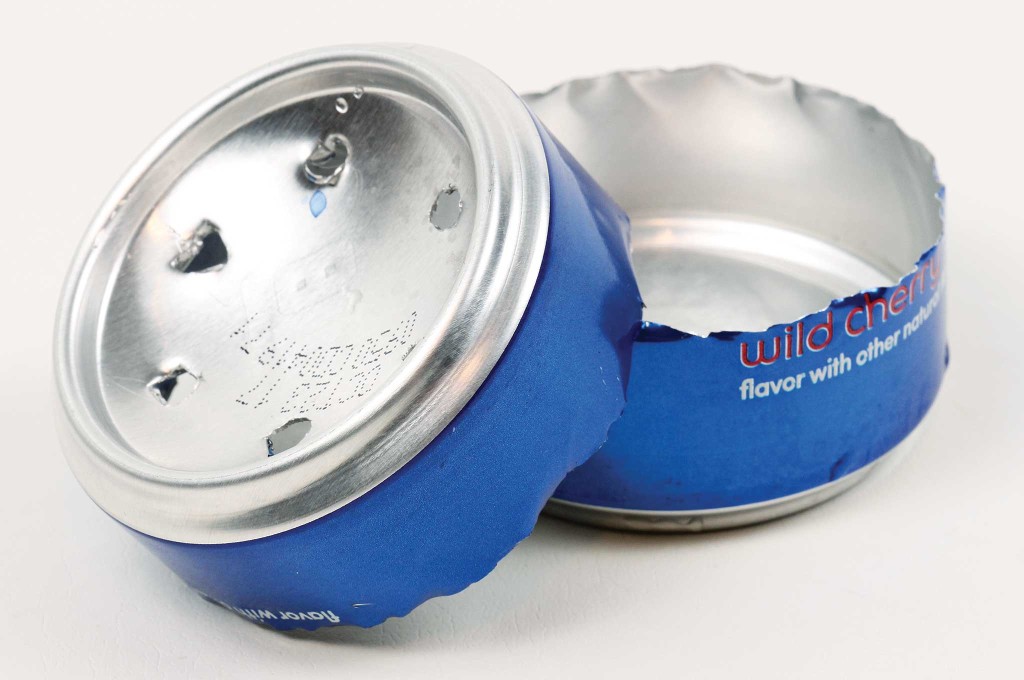
Step 2: Cut the bottom inch off both cans. Use the reamer blade again so that you can keep your other knife blades sharp for other survival tasks.
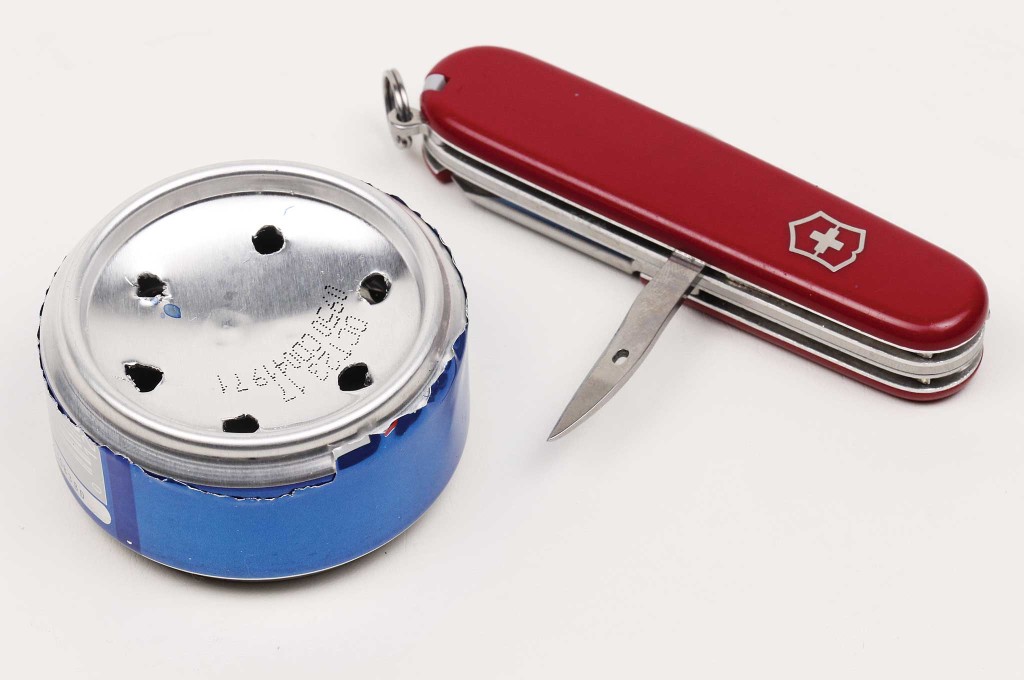
Step 3: Fit the two bottoms together — the one with holes in it goes inside the other one. You'll need to bend the edges slightly to get it started, then you'll be able to push them together. The fit will be snug.
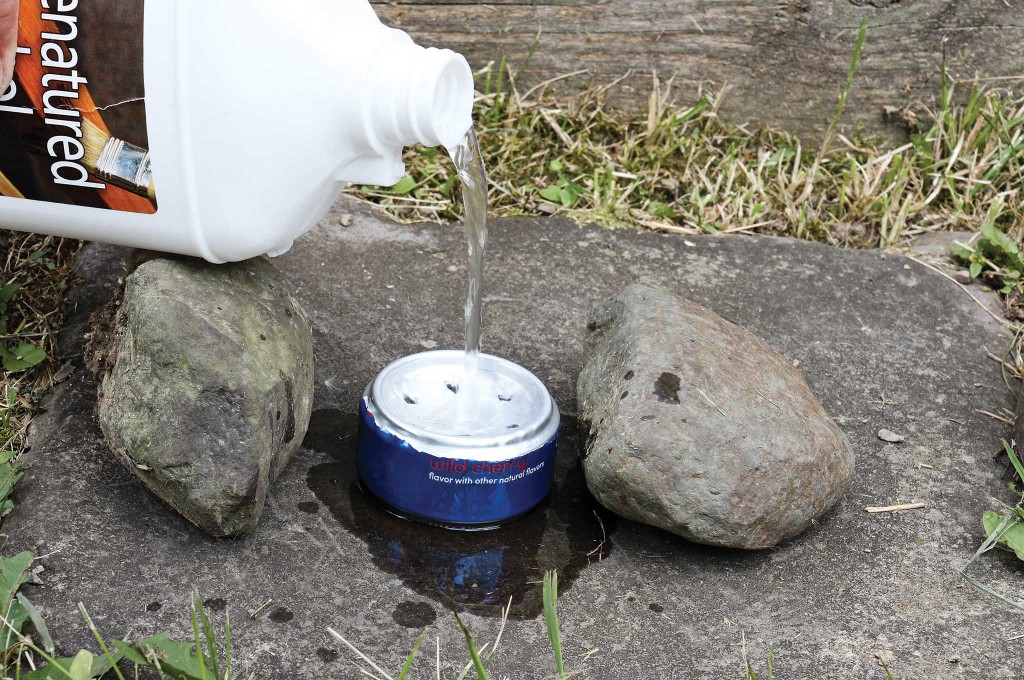
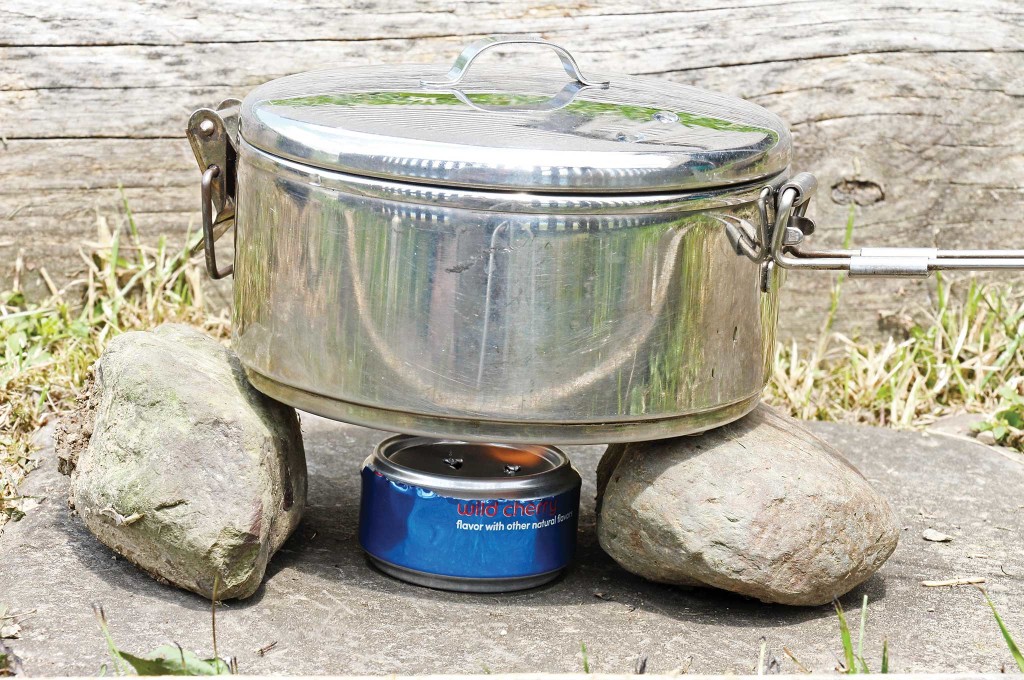
Step 4: Your stove is done. Fill it with methyl alcohol through the holes you made. Light the stove. Use stones as a pot support as you did with the tuna can.
Notes: Burn time of these stoves is usually 15 minutes. They'll boil two cups of water in 8 to 12 minutes. If yours doesn't, try adding holes to the stove, placing the cook pot closer to the stove, or configuring a windscreen around the stove. Build time for each stove is about five minutes. For the tuna can stove, that time also included eating the tuna.
Survival Use #3: Craft a You-Haul
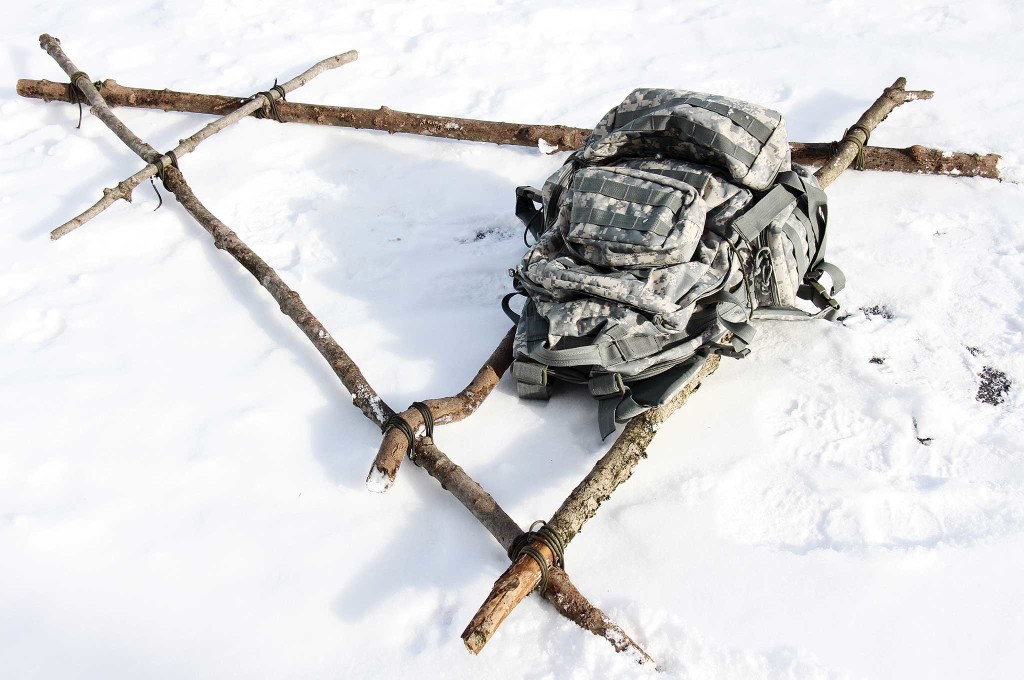
A travois is an A-frame of wooden poles used to haul heavy loads. Historically, they were pulled by horses. But you can construct smaller ones where you provide the horsepower. They can be handy if you need to move camp, haul out downed game, or get an injured companion out alive. You'll need the saw blade on your Swiss Army knife to construct it.
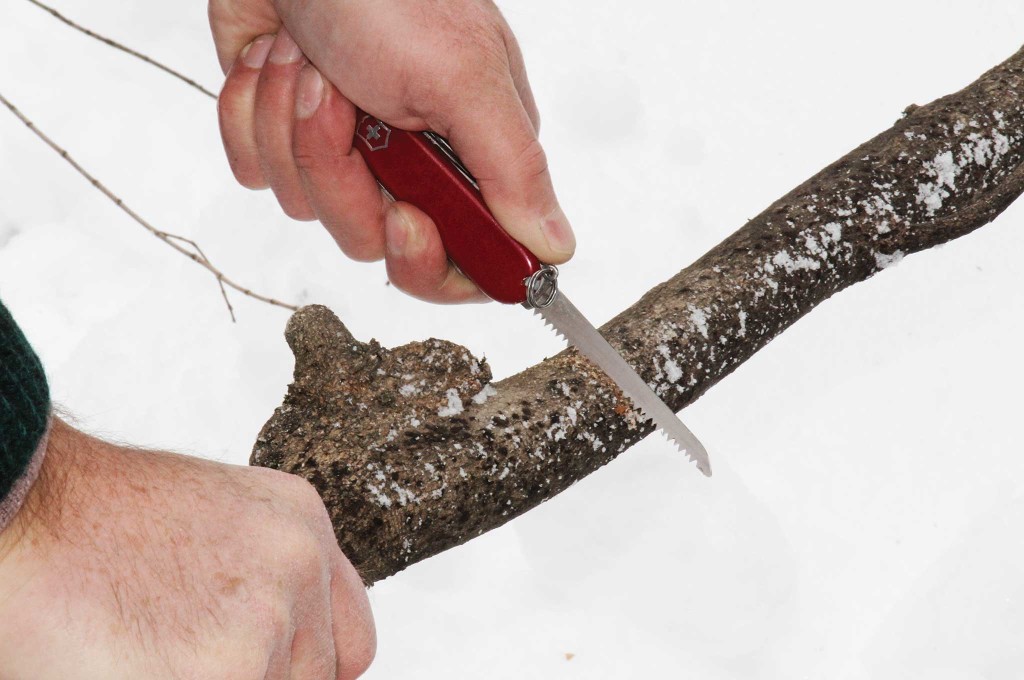
The author uses a Victorinox Hiker to saw downed saplings to make a travois.
Step 1: Cut two branches about an inch in diameter to a length of 6 to 7 feet. These will be used for the outside of your A-frame. Lash them together to form two sides of a triangle.
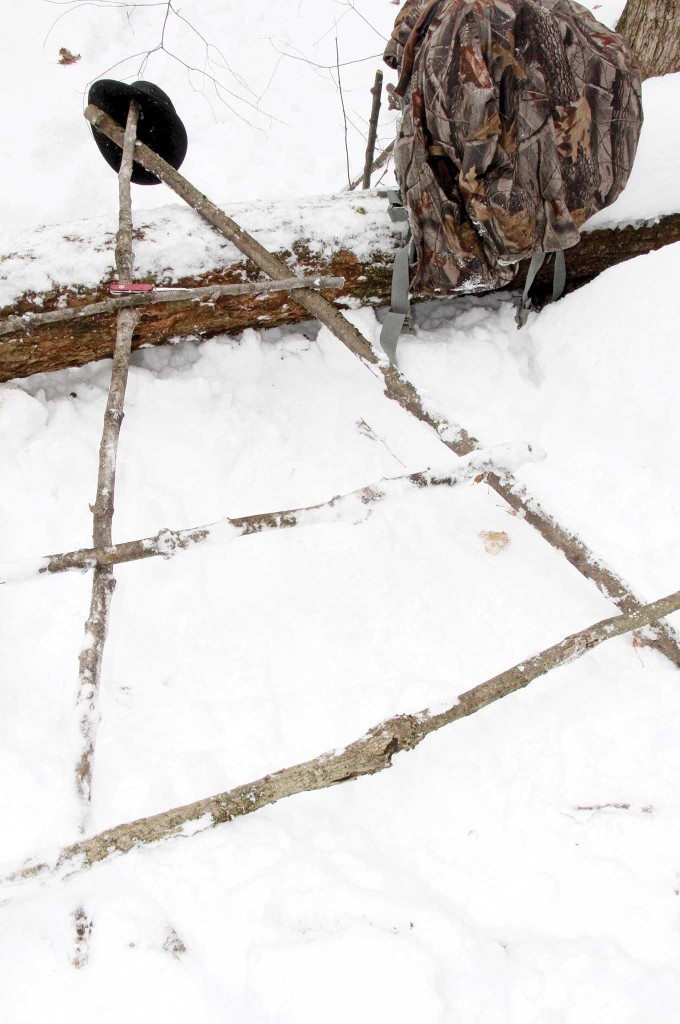
The A-frame of the travois laid out and ready to be lashed together.
Step 2: Cut one crossbar about 1 and 1/2-feet long to lash near the top of your A-frame. This will be your pushbar.
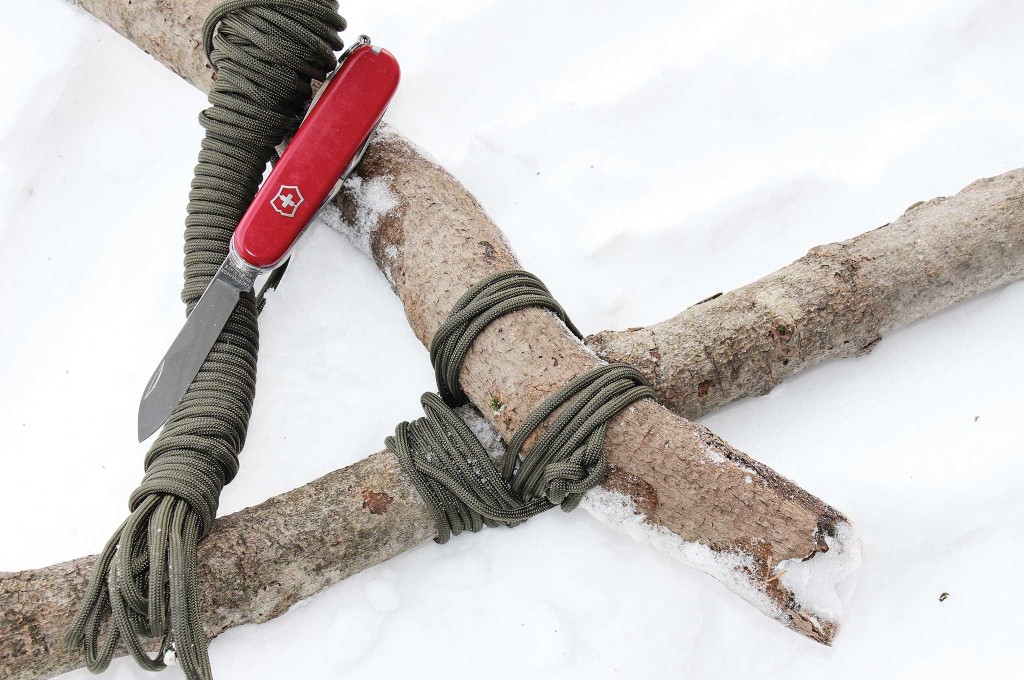
Paracord works fine for lashing wood, and the Swiss Army knife cuts the ‘cord to just the right lengths.
Step 3: Cut two or more longer crossbars and lash these at intervals across the base. You now have a travois.
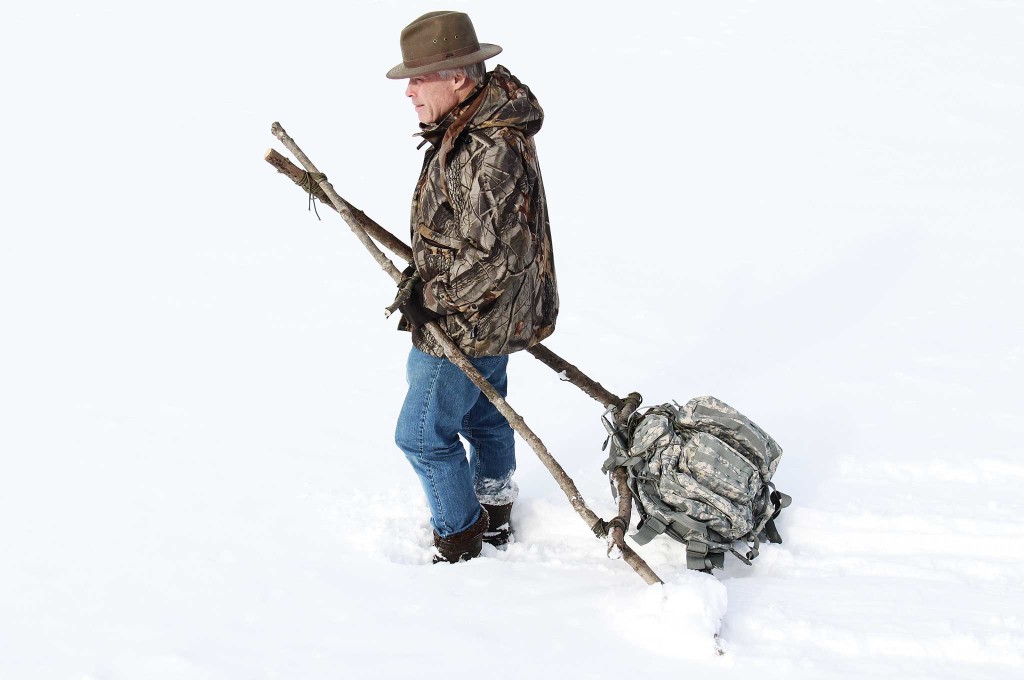
The author tests his finished travois with a pack attached to simulate the load. A travois can be a lifesaver when used...
Step 4: Strap your load to the crossbars near the base.
Step 5: Step inside the A-frame and pick it up so that the push bar is along your waist. Hold on to the frame and start walking.
Note: You can lash the pieces together with paracord if you have it. If not, get out the Swiss Army knife again. Whittle the ends of the crossbars into a triangular shape to fit dovetail notches that you cut into the side pieces as outlined in the next item. It's time consuming, but it works.
Survival Use #4: Saw a Dovetail Notch
How do you join two pieces of wood together without cordage? Use the Dovetail Notch. Basically you cut a triangular notch into one piece of wood, whittle the end of the other into a triangular shape, and fit the two together. You can use this to make a frame to hang a kettle from a campfire or to fit poles together when building a shelter — anything you need to improvise in the field when cordage is in short supply.
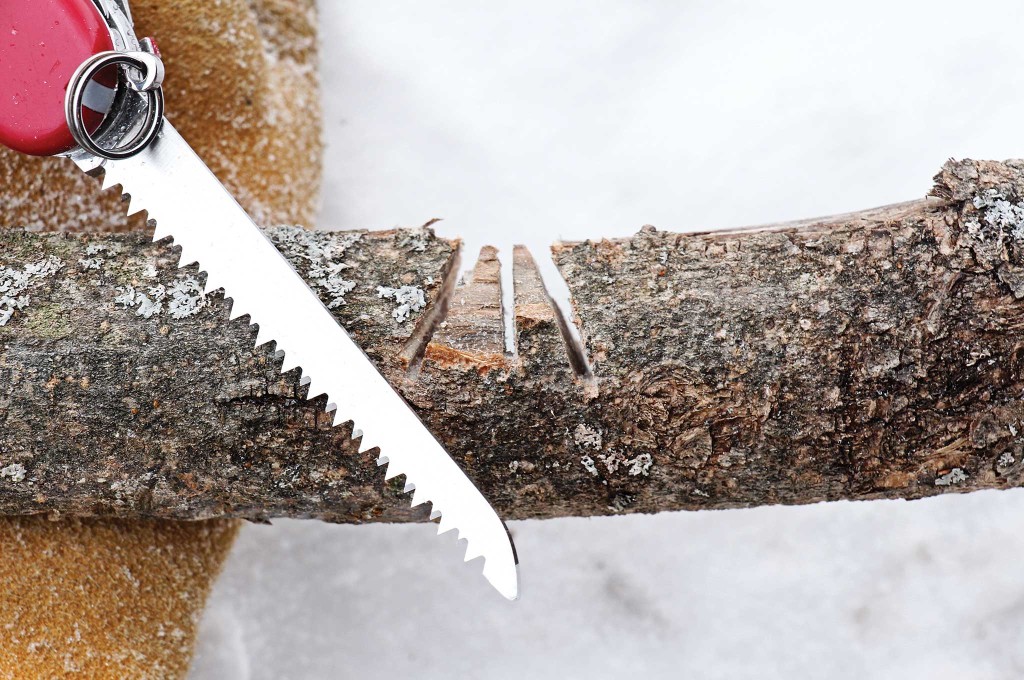
Step 1: Using your Swiss Army knife's saw blade, make three cuts about halfway into a piece of wood where you want to make the notch. The first cut should be straight down. The other two, one on each side of the first, angle away.
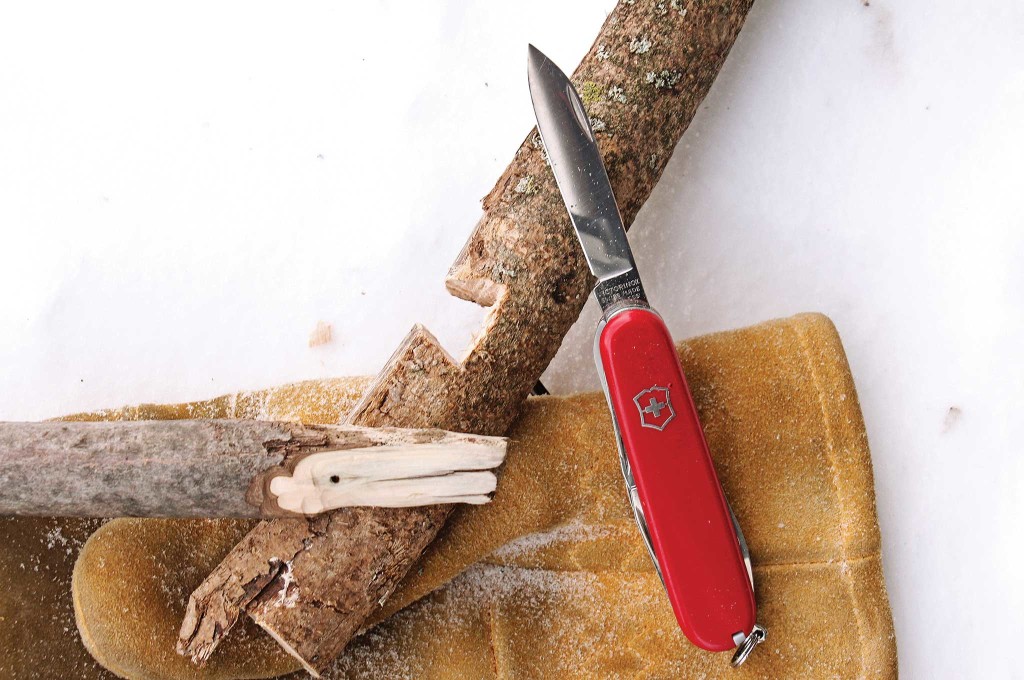
Step 2: Use the saw and knife blades to remove the wood between your cuts, leaving a triangular notch that's narrow at the top and wider toward the center of the wood.
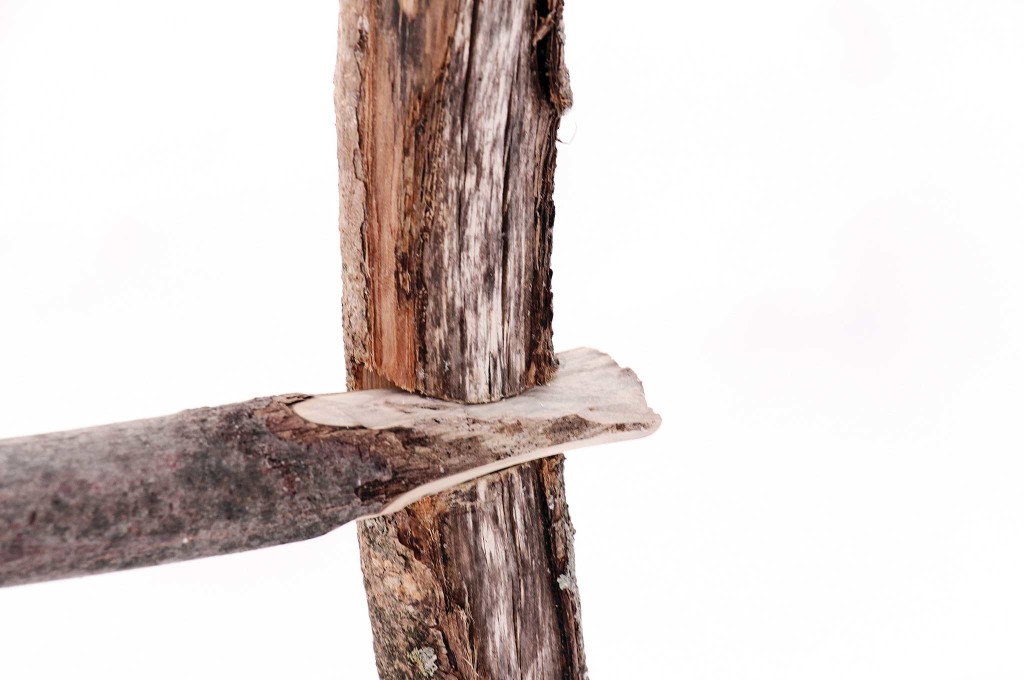
Step 3: Take the other piece of wood and carve the end into the shape of a triangle. Cut a little at a time and keep checking the fit to the notched piece until you have a tight connection.
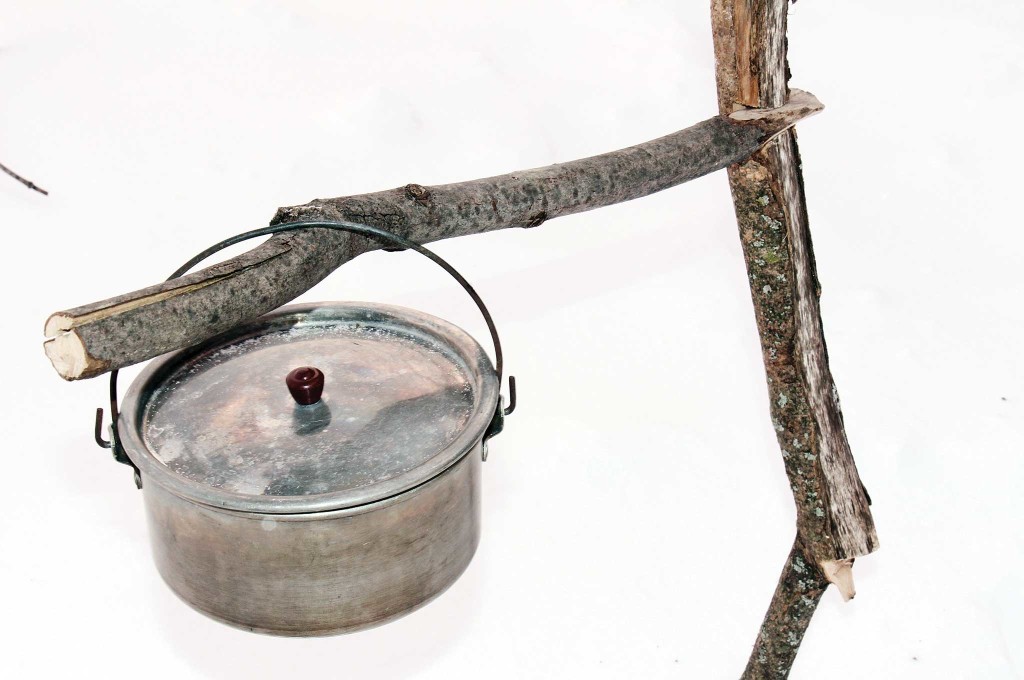
You can attach two pieces of wood using a dovetail notch, made using the saw blade of a Swiss Army Knife. This dovetail...
Note: You can further secure the pieces by melting pine sap into the connections.
Survival Use #5: Clean Your Gun
A firearm is only good if you keep it in reliable working condition. You might be faced with doing a little field maintenance if you're far from civilization, whether on a camping trip, or a hunting trip, or while bugging out from a crisis.
Task 1: Use the small knife blade or scissors of your Swiss Army knife to cut cleaning patches from a cotton shirt.
Task 2: Use the toothpick and tweezers to reach into tight places to remove debris.
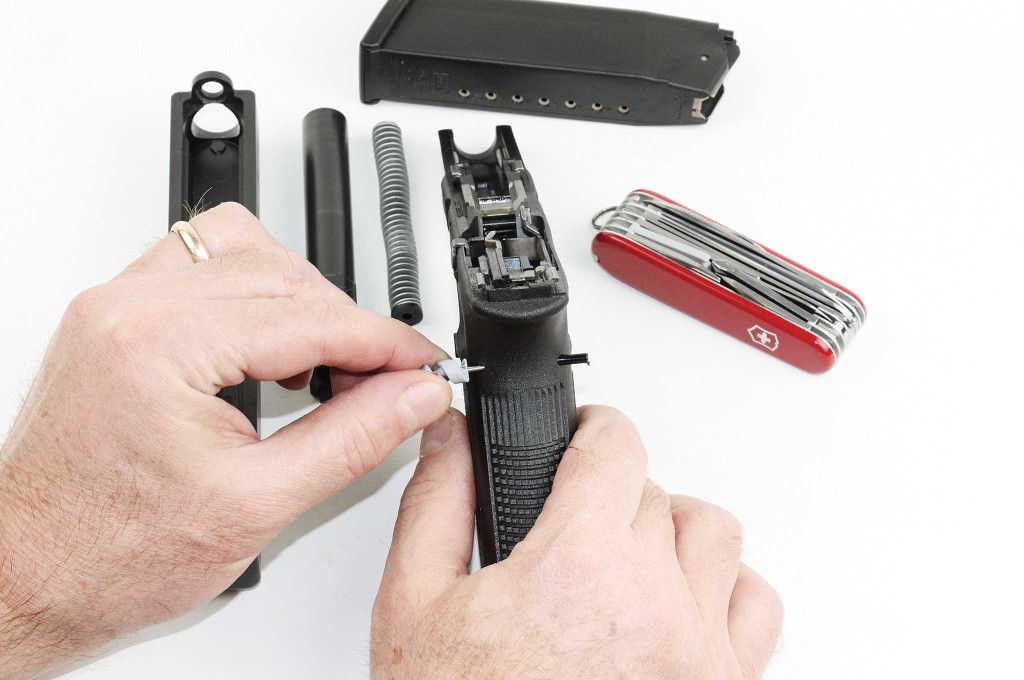
The author uses the tiny screwdriver from his Swiss Army knife as a pin punch to take down this Glock 20SF.
Task 3: Use the small screwdriver to punch pins.
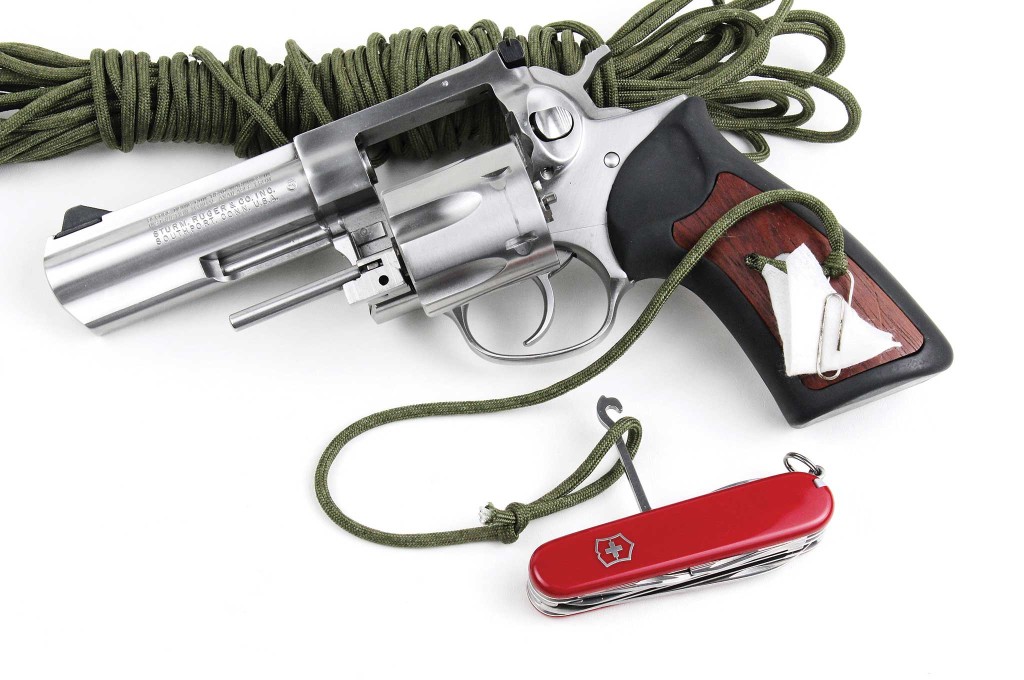
Attaching a length of paracord to the parcel hook of a Swiss Army knife makes a handy improvised pull-through bore...
Task 4: Use the parcel hook with a length of paracord to make a pull-through bore cleaner.
Task 5: Use the screwdrivers to adjust the sights or remove grip panels.
The Army Advantage
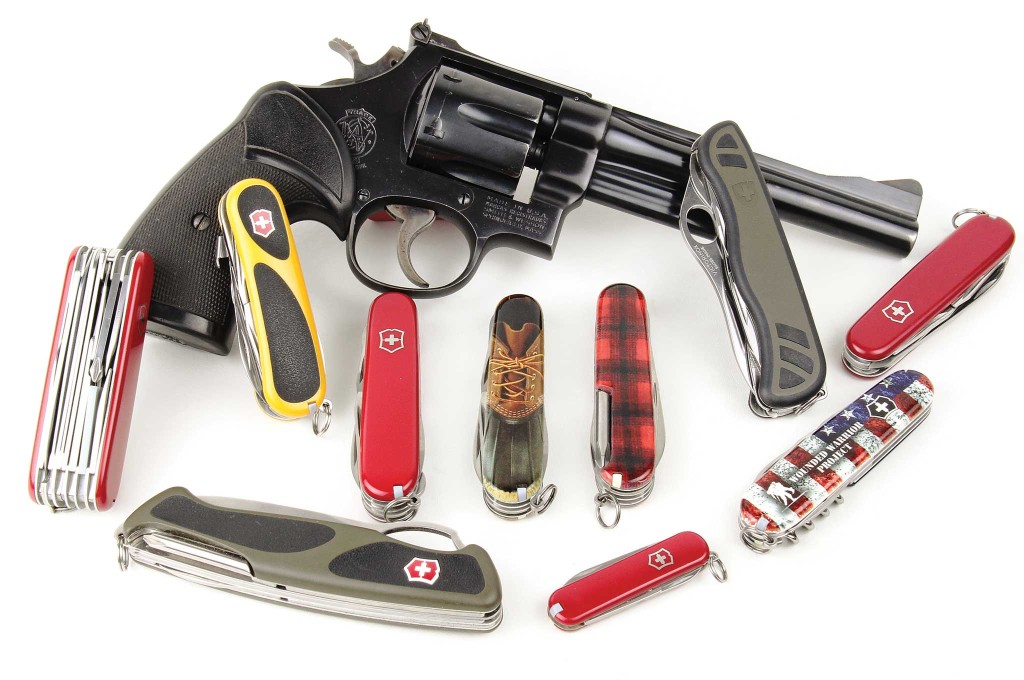
Whether in the open spaces of Mother Nature or the confines of an overcrowded city, a Swiss Army knife can help you...
A Swiss Army knife makes an excellent everyday-carry tool. It can often be carried when it's not practical or legal to carry a larger knife. They're more socially acceptable too, as they're not apt to be seen as a threat when in civilized company.
So, tap into your inner MacGyver, no matter if your travels take you to wild forests, tall peaks, or urban jungles. With a Swiss Army knife and a little imagination, you have one of the best problem-solving gadgets ever created.
And yes, in case you're wondering, we've saved the day many a time by actually using the corkscrew to open a bottle of wine.
40 Additional Uses For A Swiss Army Knife
A Swiss Army knife is an incredibly versatile tool, known for its multipurpose application in various scenarios. Here’s a list of 40 practical uses that can come in handy in everyday situations or unexpected challenges:
- Cutting Rope or Twine: The blade can quickly cut through materials for building shelters or tying down equipment.
- Opening Cans: The can opener tool makes it easy to access food when you're away from a kitchen.
- Sawing Through Wood: Handy for cutting small branches for a fire or shelter.
- Screwdriving: Tighten or loosen screws with the flathead or Phillips head screwdriver.
- Stripping Wire: Use the knife edge to strip insulation from electrical wires.
- Drilling Holes: The awl can puncture leather, wood, or other materials.
- Filing Nails: Keep your nails trim with the nail file.
- Cutting Paper: The scissors are perfect for snipping paper or trimming maps.
- Opening Bottles: The bottle opener is useful for hydration or celebrating a successful day outdoors.
- Peeling Fruit: The smaller blade is ideal for peeling or slicing fruit.
- Whittling Wood: Pass time or create tools by carving wood.
- Picking Teeth: The toothpick can help maintain dental hygiene.
- Tweezing Splinters: Use the tweezers to remove splinters or debris from skin.
- Opening Letters: Slice through envelopes easily.
- Scaling Fish: Clean and prepare a fresh catch with the scaler.
- Measuring: Some models include a ruler for quick measurements.
- Cleaning Under Nails: The knife tip or file can clean dirt from under fingernails.
- Tightening Eyeglasses: The precision screwdriver can tighten small screws on glasses.
- Punching a New Belt Hole: Modify a belt with the awl.
- Cutting Cheese: A snack is easier with a blade at hand.
- Opening Packaging: Slice through plastic or tape on packages.
- Carving Messages or Signs: Leave messages on wood or soft stone.
- Gutting Hooks: The knife can be used to remove fish hooks.
- Emergency Haircut: Scissors can trim hair if needed.
- Cutting Fishing Line: Quickly trim or cut lines when angling.
- Tightening Gear: Use the screwdrivers for on-the-fly equipment repairs.
- Scraping Surfaces: Remove stickers or clean surfaces.
- Opening Wine: With a corkscrew, enjoy a bottle of wine outdoors.
- Sealing Envelopes: Apply glue with the blade tip.
- Emergency Sewing: The needle on the awl can help repair torn gear.
- Cleaning Game: Process small game or fowl with various tools.
- Marking Paths: Carve notches or symbols in trees to mark a trail.
- Lifting Hot Cookware: The flat tool can serve as an impromptu pot lifter.
- Breaking Down Boxes: Cut cardboard for recycling or storage.
- Starting a Fire: The spark from striking steel against a rock can ignite tinder.
- Cutting Bandages: The scissors can cut cloth for first aid.
- Uncorking Champagne: Pop a celebratory bottle with the corkscrew.
- Sharpening Sticks: Create points on sticks for cooking or defense.
- Loosening Knots: The blade can pry apart tight knots.
- Signal for Help: Reflect sunlight with the polished blade as a signal mirror.
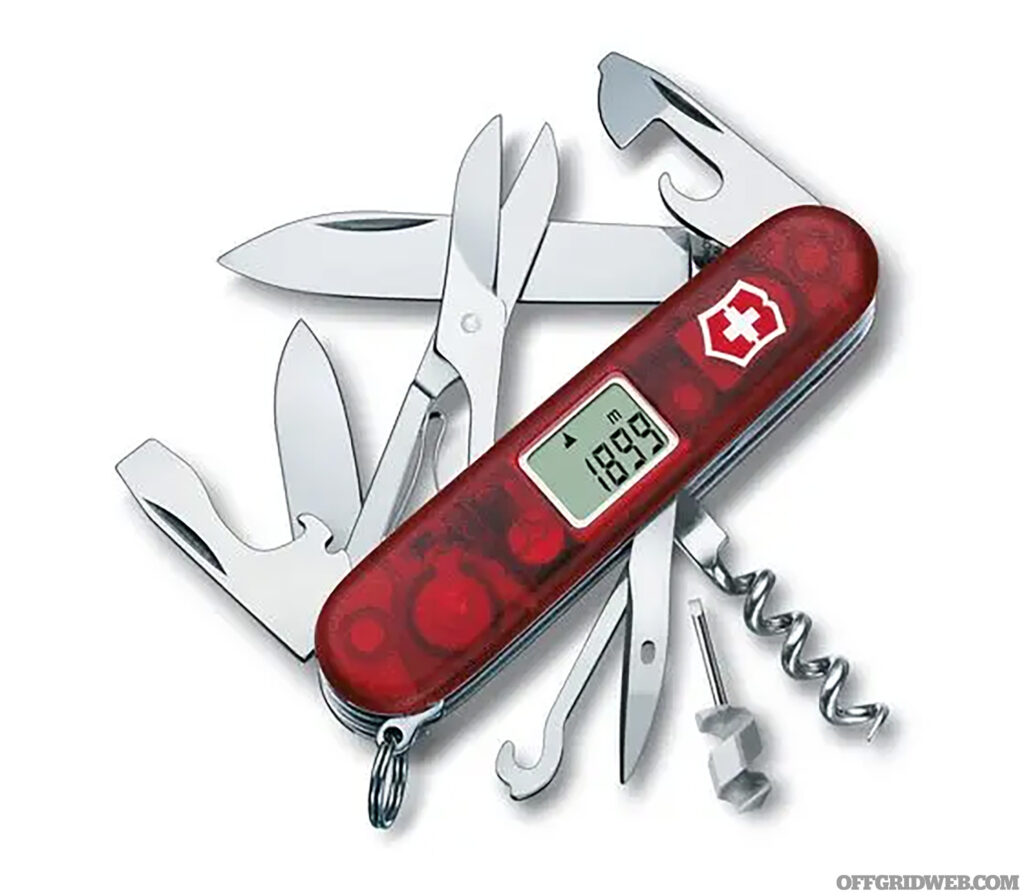
Swiss Army Knife Trivia
Which Knife? The company that would become Victorinox provided its first Soldier's Knife to the Swiss Army in 1891. But the familiar red knife with the corkscrew that we normally think of as a Swiss Army knife was actually the Officer's Knife, introduced in 1897, and it was never adopted by the Swiss Army. It wasn't until after World War II, when G.I.'s began bringing them home, that the little knife became a must-have gadget around the world.
Unlock the Puzzle: Want to test the knowledge of your “knife expert” friends? Open the locking blade of a Victorinox Rangergrip knife and see how long it takes before they can figure out how to close the blade. The Victorinox insignia on the handle is a spring-loaded button that unlocks the mechanism.
Space Age: NASA issued a Victorinox Master Craftsman model to the crews of its space shuttles. It was a German astronaut, Ulf Merbold, who used a Swiss Army knife on a shuttle mission in 1983 to rewire some electrical connections, saving some expensive scientific experiments.
Lots of Tools: The Swiss Champ, the flagship of the company's gadget knives, has 33 functions. It's made from 64 different parts and takes 450 different operations to manufacture.
Screwy idea: When a customer suggested the addition of a tiny screwdriver, the Victorinox designers didn't want to do away with the toothpick to find room for one. That's when they created the screwdriver that fits inside the corkscrew.
What's in a Name? Founder Karl Elsener began using his deceased mother's name, Victoria, as a trademark in 1909, the same year the company was given permission to put the Swiss emblem on its knives to differentiate them from imitations. In 1923, the company switched to using stainless steel and used the name Victoria Inoxyd, with inoxyd being a shortened form of the French word for stainless steel, inoxydable. By 1931, the company combined the names, and the company has been called Victorinox ever since.
The Competition: The company that eventually became known as Wenger was awarded part of the contract to provide knives to the Swiss Army in 1893. Victorinox marketed its products to the public as “the original Swiss Army knife,” while Wenger promoted its products as “the genuine Swiss Army Knife.” Victorinox acquired Wenger in 2005, and since 2013, all the knives now wear the Victorinox label.
Counterfeit Alert: Make sure you don't get stuck with an imitation. All new genuine Swiss Army knives have “Victorinox” stamped at the base of the large blade.
Real-Life Application
As the name tells us, the Swiss Army knife started out in life as a tool for Swiss soldiers. So it was meant to survive combat, training, and harsh conditions. But it's also been used as a wide variety of impromptu tools. Here's a few of the most amazing adaptations of the little red multitool:
The North Pole Shoemaker
When Tyler Fish and John Huston made an unsupported expedition to the North Pole, Swiss Army knives were a crucial part of their gear. Their success and often their survival depended on them. Fish's overboot kept popping out of the ski binding, so he used the blade, scissors, and chisel of his knife to reshape the sole of the boot to match the ski binding.
They also used the knives to keep their stoves running, guide sewing needles when they had lost feeling in their fingertips, cut bandages for blisters, screw traction skins to their skis, patch boot liners, untie frozen knots, repair ski poles, splint a busted ski tip, and fix a cracked ski binding.
The Space Station Breacher
When Canadian astronaut Chris Hadfield was docking his space shuttle to the Russian Mir space station, he found the Russians had been overzealous in sealing the hatch. Hadfield used his Swiss Army Knife “to break into the Russian space station” by cutting away the strapping and tape. The Swiss Army knife: Don't leave Earth without it.
The Other Impromptu Uses
In his excellent book, Swiss Army Knives: A Collector's Companion, author Derek Jackson recounts more truly remarkable ways Swiss Army knife owners have put these tools to work:
Faster than a Speeding Train: In Germany, a railroad worker raced to lower a stuck barrier so car traffic wouldn't cross the tracks into the path of an oncoming train. He inserted the small blade of his Swiss Army knife into the barrier's mechanism and managed to lower the barrier just in time.
Coconuts for Dinner Again? An officer in the British Army reported that during an expedition in the South Seas with his soldiers, coconuts were a regular part of their diet. They used the Swiss Army knife's reamer tool to drill out the coconut eyes.
“Bee” Careful: In South Australia, a bee flew into a bus and stung a girl who was allergic to bee stings. Another passenger used the magnifier on his Swiss Army knife to confirm that the bee's poison sac hadn't been emptied and then used the tweezers to remove the stinger.
Roadside Surgery: In Ireland in 1990, a boy on a bicycle was struck by a car and suffered serious internal injuries. Doctors in a passing car stopped and used a Swiss Army knife to insert a drain in the boy's chest while they waited for paramedics.
Grim Emergency Surgery: After his surgical saw was stolen, a Canadian doctor working in rural Uganda used the saw blade on his Swiss Army knife to perform at least six amputations.
Clothes Remover: During an expedition to the North Pole in the winter of '76-'77, British explorers routinely used Swiss Army knives to remove ice from sleds and to open cans of food. The temperature was about -34 degrees F when a member of the expedition fell through a sheet of ice. They used the Swiss multitool to cut him free of his instantly frozen clothes and were able to get him dried out before he froze to death.
A Real MacGyver: A Swiss Army knife comes in handy for urban survival situations too. In 1992, Douglas MacIver of Portland, Oregon, was stuck alone in an elevator just above the first floor of an old building. There was a fire above him in the elevator shaft and the elevator began filling with smoke. As rescuers worked to free him, he took action himself. He used his Swiss Champ knife to loosen nuts to get the elevator doors open. He then had to remove the hinges from a window on the sealed-off mezzanine level where he was finally rescued. Although he spelled his name differently, he was compared to the television character, MacGyver, who often used a Swiss Army knife to get out of tough situations.
Sources
Swiss Army Knives: A Collector's Companion
Compendium Publishing Ltd.
www.amazon.com
Victorinox Swiss Army
www.swissarmy.com
Read More
Don't forget to subscribe to Recoil Offgrid's free newsletter for more content like this.
The post Swiss Army Knife Uses: Ultimate Guide To A Classic Tool appeared first on RECOIL OFFGRID.
By: Offgrid Staff
Title: Swiss Army Knife Uses: Ultimate Guide To A Classic Tool
Sourced From: www.offgridweb.com/gear/5-surprising-uses-for-the-swiss-army-knife/
Published Date: Wed, 08 Nov 2023 12:00:12 +0000
------------------------
 What is BushcraftSurvival SkillsToolsVideosBushcraft CampsBushcraft KitsBushcraft ProjectsPrivacy PolicyTerms And Conditions
What is BushcraftSurvival SkillsToolsVideosBushcraft CampsBushcraft KitsBushcraft ProjectsPrivacy PolicyTerms And Conditions
